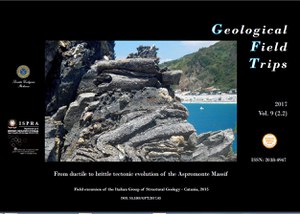From ductile to brittle tectonic evolution of the Aspromonte Massif
Field excursion of the Italian Group of Structural Geology - Catania, 2015
The two-days field trip in the Aspromonte Massif (Calabria – Southern Italy) was carried out for the annual meeting of the Italian Group of Structural Geology (GIGS, 2015) - Section of the Italian Geological Society (SGI) - in collaboration with the National Group of Petrography (GNP). It is planned to illustrate the tectono-metamorphic history of the metamorphic basement cropping out in this sector of the Southern Apennine. Attention will be focused on the complex poly-orogenic and poly-phase evolution that, since the Precambrian-Cambrian boundary, has driven the petrogenetic evolution as well as the structural features of its crystalline basements, permitting also to constrain some key aspects of the Western Mediterranean geodynamics.
Moreover, since the Aspromonte area was repeatedly struck by strong earthquakes and represents one of the key sectors for the reconstruction of the late Quaternary morphotectonic evolution of the Southern Italy, some of the stops will be devoted to the observation of the morphological, structural and sedimentary features of two of the most active structures of this sector of the belt, the Scilla and the Armo normal faults. Finally, the field trip allows to visit two coastal sites controlled by these major normal faults, respectively in the Tyrrhenian and in the Ionian sector of the Messina Strait, which display complete sequences of Pleistocene marine terraces. Due to the tectonic uplift faster than the Holocene sea level rise, these sites also show well preserved raised Holocene paleoshorelines that represent important proxies for reconstructing the paleoseismicity of this area and, in general, for the risk assessment.
From a geological point of view, the Aspromonte Massif belongs to the Calabrian Peloritani Orogen (CPO), including the Sila Massif, the Coastal Chain, the Serre Massif and the Peloritani Mountains. This sector chain, also known in literature as Calabrian Arc, has been recently interpreted as a merged ribbon-like continental crustal section constituted by two main microterranes (i.e. the northern- and southern-CPO separated by the Catanzaro line, CL), which are characterized by different tectono-metamorphic evolutions.
The amalgamation of these two different sectors can be ascribed to the intense strike-slip tectonics which accompanied the evolution of the Western Mediterranean area from Cretaceous age, presently testified, in addition to the Catanzaro line, also by the tectonic alignment of the Pollino fault zone (PFZ), Palmi line (PL) and Taormina line (TL). In particular, the Aspromonte Massif is a nappe edifice, constituting the Oligocene-Miocene accrectionary wedge of the European-Africa plate boundary. This is originated by the breakup of the earlier Southern European Variscan chain during the Mesozoic-Cenozoic Alpine orogeny. Afterwards, during Eocene-Quaternary times, it has also been involved in the subduction of the Ionian slab and in extensional and uplifting processes that make this area one of the most seismically active of the entire Mediterranean realm.
DOI: 10.3301/GFT.2017.03

